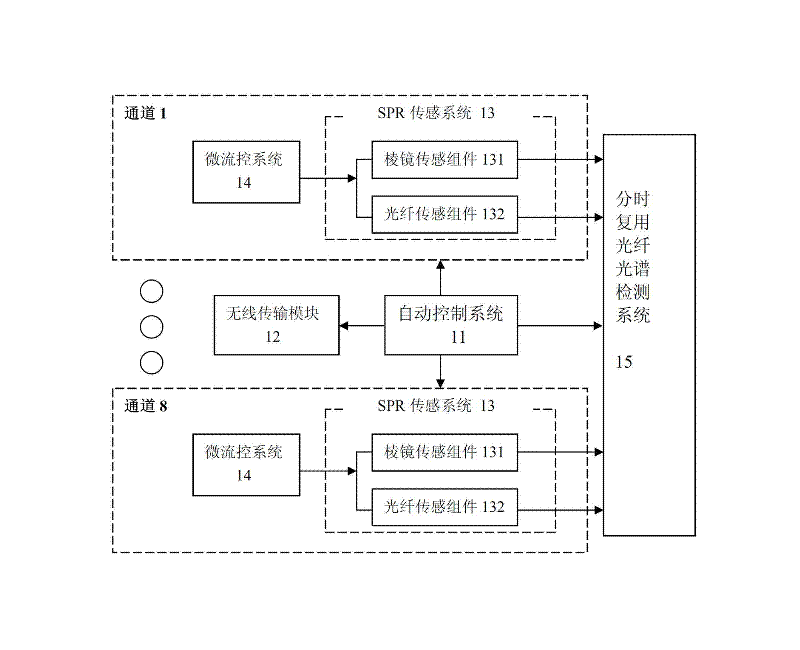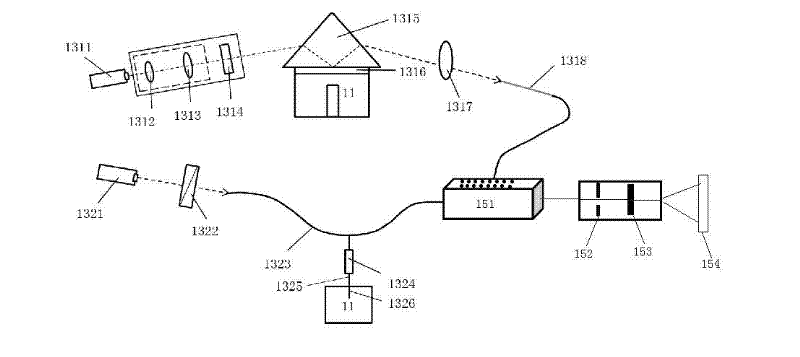Multi-channel wireless cascade surface plasma resonance spectrometer
A surface plasmon and plasmon resonance technology, applied in instruments, scientific instruments, material analysis by optical means, etc., can solve problems such as the inability to meet the needs of high-throughput detection, reduce instrument costs, ensure instrument performance, and facilitate and flexible configuration Effect
- Summary
- Abstract
- Description
- Claims
- Application Information
AI Technical Summary
Problems solved by technology
Method used
Image
Examples
Embodiment 1
[0019] See attached figure 1 As shown, a multi-channel wireless cascaded surface plasmon resonance spectrometer is composed of several independent 8-channel surface plasmon resonance spectrum wireless detection modules 1 (8-channel-SPR), and a main control computer 2, using Wi-Fi (IEEE 802.11) wireless communication method for two-way data transmission. Among them, the 8-channel-SPR wireless detection module 1 is responsible for the high-throughput detection of multi-channel samples, and sends the detection data to the main control computer through the wireless network in real time, and at the same time accepts the control instructions of the main control computer; the main control computer 2 is used for Wireless data reception, data processing and centralized control. According to specific application needs, 1~12 8-channel-SPR wireless detection modules can be configured arbitrarily, and the main control computer can automatically identify 8-channel-SPR modules in the area, ...
Embodiment 2
[0021] see figure 2 As shown, the 8-channel surface plasmon resonance spectrum wireless detection module is composed of 8 independent detection channels. Except that the automatic control system 11, the wireless transmission module 12 and the time-division multiplexing optical fiber detection system 15 are shared by 8 channels, other micro The flow control system 14 and the SPR sensing system 13 are independent sets for each channel. The core of the microfluidic system 14 is the microfluidic sample cell, which is responsible for the delivery of the mixed solution of the sample and the mobile phase, and precisely controls the flow rate and stability of the fluid in the sample cell. The SPR sensing system 13 detects and analyzes the samples in the sample pool, adopts the wavelength modulation method, and selects the prism sensing component 131 or the fiber optic sensing component 132 according to the specific application requirements, breaking the prism sensing unit or the fibe...
Embodiment 3
[0023] see image 3 As shown, the single-channel SPR sensing detection system includes a prism sensing component 131, an optical fiber sensing component 132 and a time-division multiplexing optical fiber detection system 15, etc., wherein the prism sensing component 131 and the optical fiber sensing component 132 are based on user needs Choose one. The prism sensing component light source 1311 and 1321. The optical fiber sensing component light source 1321 uses a halogen tungsten light source; the prism sensing component 131 adopts a cylindrical prism 1315, and its cross section is an isosceles triangle, and the bottom surface is coated with a flat metal reflective film 1316, the waist The incident high-reflection film and the exit high-reflection film are respectively coated on the surface, and the outgoing light of the prism is coupled into the optical fiber 1318 after being focused by the lens 1317, and then enters the time-division multiplexing optical fiber detection syst...
PUM
 Login to View More
Login to View More Abstract
Description
Claims
Application Information
 Login to View More
Login to View More - R&D
- Intellectual Property
- Life Sciences
- Materials
- Tech Scout
- Unparalleled Data Quality
- Higher Quality Content
- 60% Fewer Hallucinations
Browse by: Latest US Patents, China's latest patents, Technical Efficacy Thesaurus, Application Domain, Technology Topic, Popular Technical Reports.
© 2025 PatSnap. All rights reserved.Legal|Privacy policy|Modern Slavery Act Transparency Statement|Sitemap|About US| Contact US: help@patsnap.com



